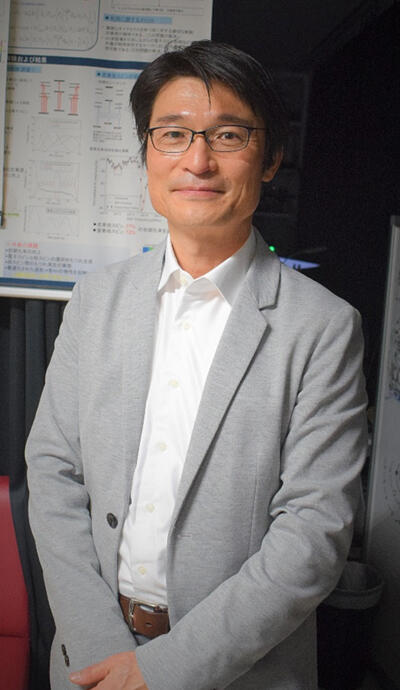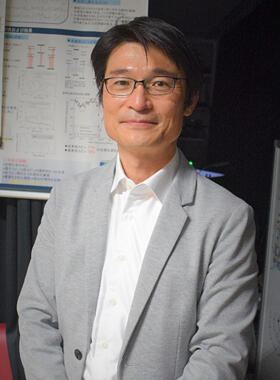Persistence and earning respect through quantum repeater technology for long‐distance communication
"I really want to make the quantum internet a reality." Professor Hideo Kosaka of Yokohama National University, is enthusiastic about working on the Moonshot R&D program "Quantum Interface Development for Quantum Computer Network Construction" (QuINT) and the Ministry of Internal Affairs and Communications' research and development for building a global quantum cryptography communication network, Quantum Repeater (QuREP). The projects are now in the middle of phase two.

Provided by Yokohama National University
"I originally worked on semiconductor lasers and other research, but I first became involved in a quantum repeater project at TAO (formerly the Telecommunications Advancement Organization of Japan, the predecessor of the National Institute of Information and Communications Technology) when I was at NEC," explains Kosaka. "From that point up until now, I've been working on research and development toward the realization of the quantum internet for about 25 years. In the beginning, people made fun of me when I said I was doing quantum research, but after being persistent, I am now respected." He adds, "After all, the focus on quantum computers was probably a major turning point."
In telecommunications, transmitting information over long distances is accomplished with repeaters that amplify optical and electrical signals, which would otherwise be attenuated over long distances. For example, in optical communications, a weakened light is received, converted into an electrical signal and then relayed by emitting a laser carrying the same information. However, quantum communication is an entirely different game. One of the advantages of quantum communication is that it ensures secure communication because the quantum state changes when it is listened in on, but if the quantum state is read at a repeater and transmitted again, it is possible to listen at the repeater.
He explains, "The quantum internet has three stages: in the first stage, only the quantum key is sent via quantum communication, and the quantum key is used to decrypt the encrypted information sent over the normal internet. This is called quantum key delivery (QKD). This has already been achieved and is called the QKD network. The network is built on the belief that the repeater is safe. The second stage is a QKD system in which quantum keys are relayed by a beam splitter, which has been completed up to proof of principle. Furthermore, quantum information itself is exchanged and relayed over a network in the third stage, the quantum internet." "Once this is achieved, it will be possible, for example, to connect quantum computers in different locations to build a giant quantum computer. QuINT will develop a quantum interface that combines quantum memory and optomechanical crystals to link superconducting qubits with photons for communication. QuREP is developing quantum relay technology for long‐distance communication," he adds.
A team made of Japan's strongest members
To advance QuINT and QuREP, the Quantum Information Research Center was established at Yokohama National University in October 2020, and Kosaka was appointed its director. In addition to leading members from Yokohama National University, the center has talented members from Technical University of Munich (Germany), Ulm University (Germany), Saarland University (Germany), the University of Tokyo, NICT, NIMS, NIMS, AIST, National Institutes for Quantum Science and Technology, Tokyo Medical and Dental University, Kyoto University and RIKEN participating in the project. "We now have Japan's strongest nanotech group of around 50 people working together. For example, QuINT has three research teams working on diamond quantum memory, optomechanical resonators and piezoelectric microwave resonators," he explains.
The group already has various accomplishments under their belt. For example, a proof‐of‐principle quantum interface was demonstrated in which a diamond quantum memory is sandwiched between photonic crystals to output microwave photons from a superconducting qubit as photons, while also preserving their quantum state. "If you try to increase the number of qubits in a superconducting quantum computer, it inevitably becomes too big to fit into a refrigerator.
So, by converting the quantum information of the qubits into light, it is possible to connect quantum computers to each other." At QuREP, Yokohama National University has taken the lead in developing elemental technologies related to quantum repeating by building a close collaboration team of industry, academia and government that includes Toshiba, Furukawa Electric and Hamamatsu Photonics. The aim is not probabilistic quantum repeating, where relaying can be done only once using a beam splitter, but deterministic quantum repeating, where relaying can be done many times. "We are developing quantum relay technology using diamond NV." Kosaka continues, "Delft University of Technology in the Netherlands has succeeded in a three‐node diamond quantum relay in a strong magnetic field, so we are ahead in the proof‐of‐principle of the quantum internet, but our method can win because of its high fidelity in a zero magnetic field. The diamond quantum memory has already achieved its initial targets for the elemental functions of on‐demand quantum repeating (gate operation fidelity and time, electron and photon entanglement generation fidelity, memory retention time, single event readout fidelity, quantum error correction fidelity, etc.). At the moment, we are linking individual functions together to operate as a total quantum transponder, and are carrying out research and development to increase the bit rate."
Actively developing talent
Kosaka is also actively involved in developing talent. In addition to actively supporting research groups led by young researchers and students involved in quantum physics and the human resource development program of the National Institute of Information and Communications Technology (NICT), Yokohama National University holds a hands‐on program where undergraduate students can join a laboratory at an early stage and experience cutting‐edge research. In addition, he chairs the Japan Society of Applied Physics' Quantum Information Engineering Research Group, which organizes symposia twice a year, and also cooperates with the Quantum Internet Task Force, which is made up of younger members such as Moonshot members. "We need to train young people, because it is the elderly, including myself, who are at the center of quantum in Japan. However, universities do not have an adequate environment for manufacturing, so they simulate and design, and outsource the machining," he explains. "If Japan really wants to regain its competitiveness, I think it is necessary to create an environment at each university where people can build their own equipment and repeat experiments."

Profile
Hideo Kosaka
M.Sc., Kyoto University, 1989; PhD, Kyoto University, 1999; joined NEC Opto‐electronics Research Laboratories in 1989. Associate Professor, Research Institute of Electrical Communication, Tohoku University, from 2003; Professor, Graduate School of Engineering, Yokohama National University from 2014, moved to his current role as a Professor, Yokohama National University, in 2020. Director of the Quantum Information Research Center.
This article has been translated by JST with permission from The Science News Ltd. (https://sci-news.co.jp/). Unauthorized reproduction of the article and photographs is prohibited.




